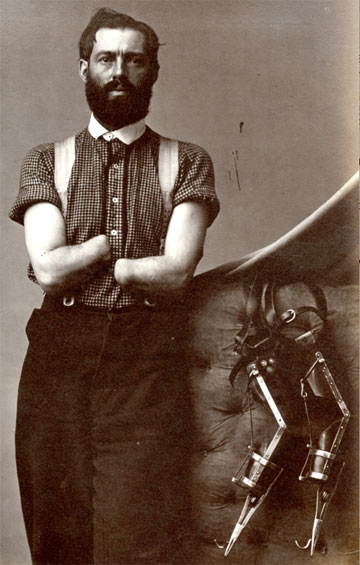
If the success of the recent movie “Lincoln” demonstrates anything, it’s that the Civil War is still a popular topic after 150 years, and with good reason. The war led to monumental changes in every aspect of American life, from politics and economics to culture and, of course, medicine.
Now, a special Harvard Medical School exhibit, entitled “Battle-scarred: Caring for the Sick and Wounded of the Civil War,” highlights the war’s impact on medicine. The exhibit is on display at the Francis A. Countway Library’s Center for the History of Medicine. The collection includes a wide array of items including photographs, surgical instruments, books and letters from the war.
“Medicine evolved significantly during the Civil War,” said Scott Podolsky, director of the Center for the History of Medicine. “And through the materials we have in the exhibit, we can really see where the changes took place.”
Chloroform, for example, started to be used regularly as an anesthetic during Civil War surgeries, especially amputations. A relatively new discovery at the time, chloroform was quickly incorporated into medical practice.
Also, because of the rising number of amputee soldiers, the market for prosthetics boomed during the war. In Massachusetts, for example, the Salem Leg Company became the official prosthetics maker recognized by the Union government and army.

“The collection is incredibly visual,” said Dominic Hall, curator of the Warren Anatomical Museum at Countway and one of the curators of this Civil War exhibit.
“The types of wounds that we see in the osteological [bone] specimens is different than before [the war],” said Hall. “The new weaponry being used during the Crimean and American Civil Wars was much more effective in causing damage: Bullets were softer and fired more accurately. They would disseminate damage to the muscle and bone upon contact.”
Studying the osteological remains informs historians not only about medicine but also about warfare.
The biggest medical changes, however, came in the form of medical infrastructure. With the high number of casualties (roughly 750,000 estimated by historians in April 2012), new problems cropped up. Generals and physicians had to develop more efficient methods for moving bodies off battlefields and getting the wounded to hospitals.
“We see the evolution of ambulance services and, as President Drew Faust has written, the need to bury and account for large numbers of dead soldiers,” said Podolsky.
Along with configuring medical services came the task of configuring military pensions.
“Pensions were a huge financial undertaking,” said Jack Eckert, public services librarian and one of the curators of this exhibit, “and we have several legal documents—affidavits, pension requests—that show us so.”
The materials in the exhibit come from a variety of sources. Some are gifts, some have been in the Countway’s collection for years and others have been donated by the Army Medical Museum. In particular, photographs of disabled soldiers were taken at the Museum.
Many of the artifacts included in the exhibit, however, come from all over the country.
“We have a large assortment of Confederate material, including several surgical manuals,” said Eckert. “The most compelling thing about the Civil War for me is the incredible amount of documents we have from everyone.”
The war’s impact was so far-reaching that it wasn’t just soldiers and doctors keeping records, but soldiers’ families, merchants, writers and people from all other areas of society as well.
“We can pull together everyone’s experience and learn about the war in a much more meaningful way,” Eckert said.
One of these non-medical materials includes a set of commemorative medals that was sold at events called sanitary fairs.
“Communities would often come together to put together a sanitary fair to raise funds for the war efforts and they would sell these medals to collect money,” said Eckert.
One of the artifacts the two curators find most interesting is a wooden chess set that was hand carved by a Union soldier who was also a Framingham, Mass., physician, and a Harvard Medical School graduate named Zabdiel Boylston Adams. Adams and fellow prison-mate Fred Guyer carved the set when they were recovering from injuries at Crumpton Hospital in Lynchburg, Va., as well as when they were Confederate prisoners in Libby Prison outside Richmond, Va.

“It’s certainly unique among the other things we have in the collections,” said Hall. “And it can be traced back to Harvard Medical School, so the legacy makes this piece special.”
While materials within the exhibit are inspiring and offer an interesting look at life during a difficult time in history, other Civil War artifacts strike a chord that still resonates in contemporary times.
“The government during the Civil War confronted such topics as the role of the state in providing health care to wounded veterans; those issues still remain relevant today,” said Podolsky.
The Center hosted a special event to commemorate the 150th anniversary of the Civil War as well as the exhibit. Harvard University president and Lincoln Professor of History Drew Gilpin Faust lectured on “Civil War and the End of Life.” Jeffrey Reznick, chief of the History of Medicine Division at the National Library of Medicine and National Institutes of Health, spoke about “Disability and the Cultural History of the Civil War.”
The exhibit is open for viewing at Countway Library. People can also view some materials from the collection at the Center for the History of Medicine’s OnView website.


